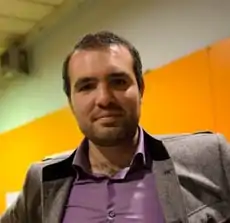Guillem Anglada-Escudé
Guillem Anglada-Escudé (born in Ullastrell, Barcelona in 1979), is a Spanish astronomer.[1][2] In 2016, he led a team of astronomers under the Pale Red Dot campaign,[3] which resulted in the confirmation of the existence of Proxima Centauri b, the closest potentially habitable extrasolar planet to Earth, followed by the publication of a peer-reviewed article in Nature.[4][5][6][7][8] In 2017, Anglada-Escudé was named amongst the 100 most influential people according to Time,[9] and one of Nature's top 10 scientists of the year 2016. [10] He is currently a research fellow at Institut de Ciències de l'Espai.[11]
Guillem Anglada-Escude | |
|---|---|
 Guillem Anglada | |
| Born | 1979 |
| Nationality | Spanish |
| Alma mater | University of Barcelona PhD |
| Known for | Search for extrasolar planets |
| Awards | Time 100 list of the most influential people in the world (2017) |
| Scientific career | |
| Fields | Astronomy, Planetary science, Astrophysics |
| Institutions | Institut de Ciències de l'Espai (2019-) Queen Mary University of London (2013–2019) University of Hertfordshire (2014-2015) University of Göttingen (2012-2013) Carnegie Institution of Washington (2008-2011) |
| Thesis | Experiments and relativistic models for optical astrometry from space. Application to the Gaia mission (2007) |
| Doctoral advisor | Jordi Torra, Sergei A. Klioner |
| Website | www |
| External video | |
|---|---|
Publications
- "A terrestrial planet candidate in a temperate orbit around Proxima Centauri". Nature. 327 (5968). 2016. arXiv:1609.03449. doi:10.1038/nature19106.
- "Two planets around Kapteyn's star: a cold and a temperate super-Earth orbiting the nearest halo red dwarf" (PDF). Monthly Notices of the Royal Astronomical Society. 443 (1). 2014. doi:10.1093/mnrasl/slu076.
- "The HARPS-TERRA project I. Description of the algorithms, performance and new measurements on a few remarkable stars observed by HARPS". The Astrophysical Journal. 200 (2). 2012. arXiv:1202.2570. doi:10.1088/0067-0049/200/2/15.
- "Design and Construction of Absorption Cells for Precision Radial Velocities in the K Band Using Methane Isotopologues". Publications of the Astronomical Society of the Pacific. 124 (916). 2012. arXiv:1205.1388. doi:10.1086/666489.
References
- "NASA Astrobiology Institute".
- "Finding Proxima b: the 'planet hunters' searching for signs of alien life around nearby stars".
- "Follow a Live Planet Hunt!". European Southern Observatory. 15 January 2016. Archived from the original on 9 June 2019. Retrieved 24 August 2016.
- "Planet Found in Habitable Zone Around Nearest Star – Pale Red Dot campaign reveals Earth-mass world in orbit around Proxima Centauri". European Southern Observatory. 24 August 2016. Archived from the original on 21 March 2019. Retrieved 10 January 2017.
- Witze, Alexandra (24 August 2016). "Earth-sized planet around nearby star is astronomy dream come true" (PDF). Nature. 536 (7617): 381–382. Bibcode:2016Natur.536..381W. doi:10.1038/nature.2016.20445. PMID 27558041. Retrieved 24 August 2016.
- "Planet Found in Habitable Zone Around Nearest Star". European Southern Observatory. 24 August 2016. Archived from the original on 9 July 2019.
- Wall, Mike (24 August 2016). "Found! Potentially Earth-Like Planet at Proxima Centauri Is Closest Ever". Space.com. Archived from the original on 3 July 2019.
- Knapton, Sarah (24 August 2016). "Proxima b: Alien life could exist on 'second Earth' found orbiting our nearest star in Alpha Centauri system". The Telegraph. Archived from the original on 26 August 2016. Retrieved 24 August 2016.
- "Natalie Batalha, Guillem Anglada-Escudé and Michaël Gillon".
- "Nature's 10".
- "Institute of Space Sciences".
External links
This article is issued from Wikipedia. The text is licensed under Creative Commons - Attribution - Sharealike. Additional terms may apply for the media files.